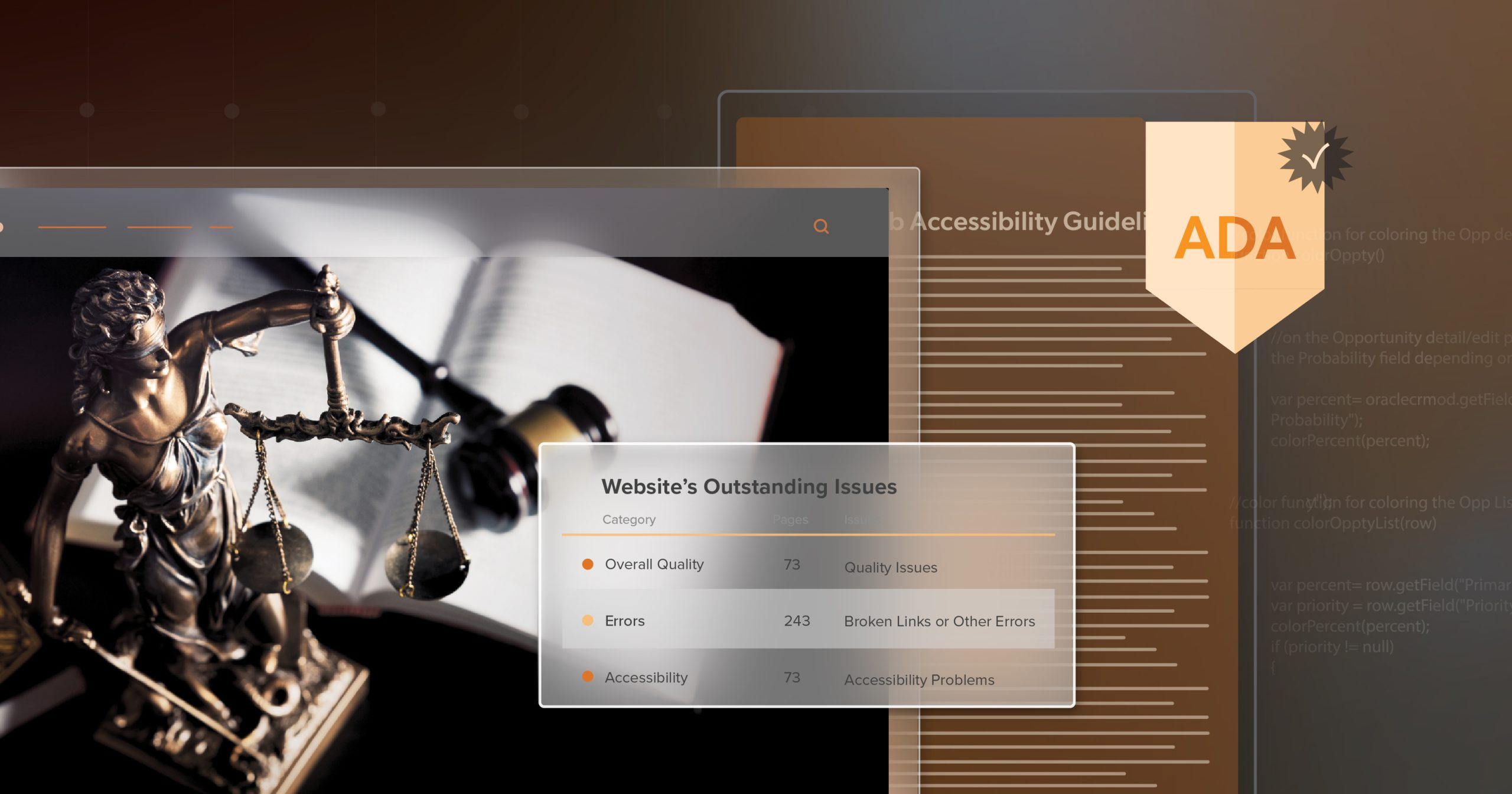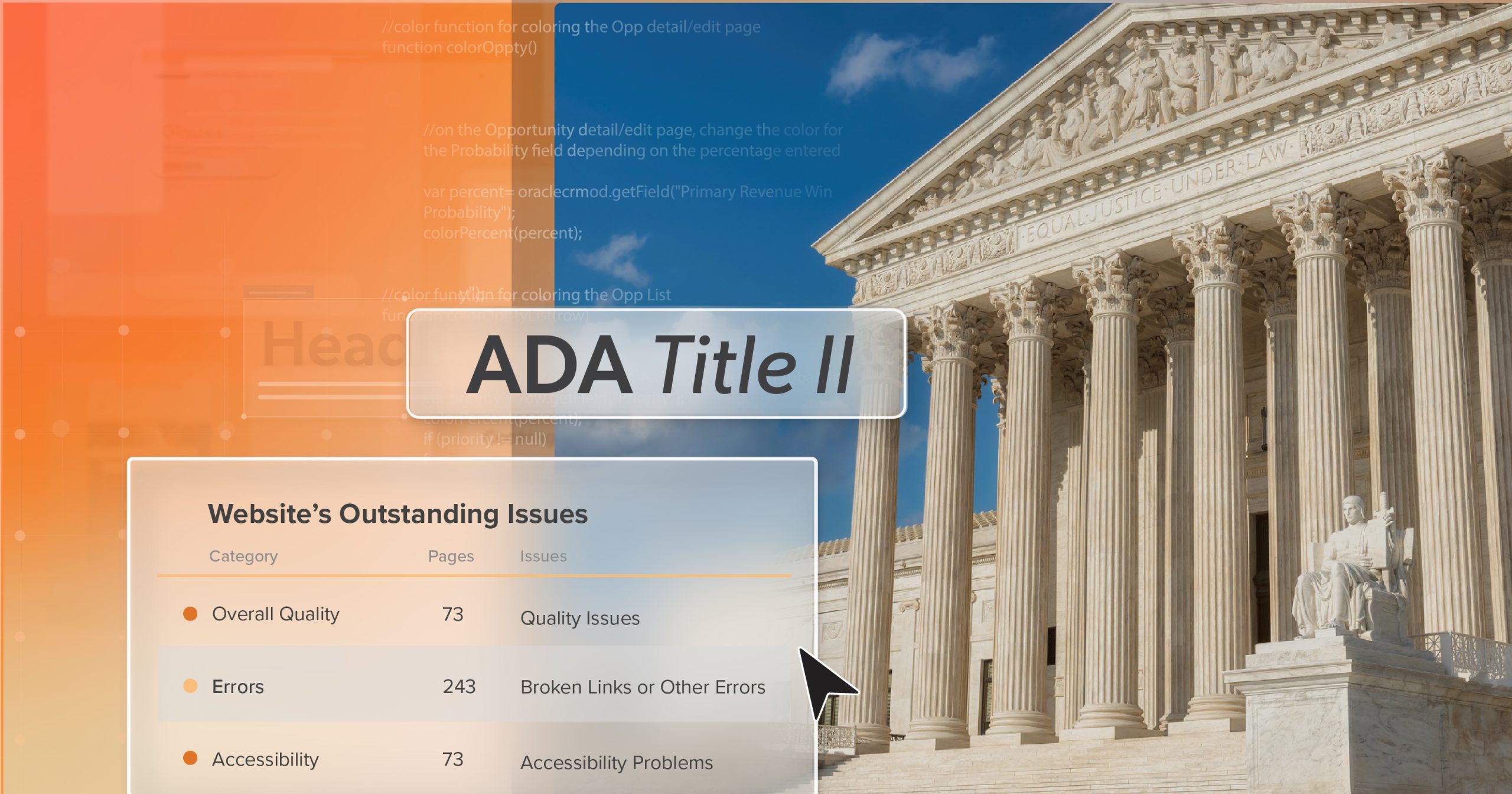You’ve likely read a headline about an ADA website lawsuit and instantly worried about your own site.
You know these lawsuits are out there. You’ve heard about demand letters landing out of nowhere. But how close is that risk to your website? Is your site a likely target… or are you losing sleep over something you don’t have a clear way to measure?
A lot of people who work on websites sit in that same uneasy space:
- Worried a letter will show up right before a busy season or launch
- Hearing mixed messages about what the ADA expects online
- Unsure whether they’re focusing on the right problems—or missing something big
Meanwhile, the numbers keep climbing. Digital accessibility lawsuits reached 4,187 cases in 2024. Current tracking puts 2025 on pace for roughly 4,975 cases—a jump of about 20%. These cases are not limited to major national brands. Retailers, hospitality, professional services, and local businesses of all sizes are in the mix.
From our perspective as a team at 216digital, the hardest part for most teams is not a lack of care. It’s the uncertainty. It is difficult to plan when you don’t know your website’s risk of being targeted. That’s the gap the ADA Website Risk Profile is designed to address: giving website teams something more solid than instinct to work from.
Making Sense of ADA Website Risk in a Shifting Landscape
Part of that uncertainty comes from the legal “grey area” around how courts treat websites.
A commonly cited example is Gil v. Winn-Dixie, in which a blind customer challenged a grocery chain because he could not use its website with a screen reader. Different courts treated the website differently and debated whether it counted as a “place of public accommodation” under the Americans with Disabilities Act (ADA). That back-and-forth created confusion and left room for aggressive litigation strategies. The end result: more questions than clear direction.
However, while courts work through definitions, plaintiffs’ firms are not waiting. Specialized firms and recurring “tester” plaintiffs look for websites with obvious barriers. In some jurisdictions, tester standing is still recognized, and serial plaintiffs have filed hundreds or even thousands of cases over the last decade.
Many organizations don’t think seriously about legal exposure until a demand letter shows up—often on a Friday afternoon when the team is already stretched thin. By that point, choices narrow and the pressure rises.
How One Client’s Threat Changed Our Approach
Our risk work started with one very real scare.
In 2018, a long-time client contacted us after receiving an ADA noncompliance threat. This was an organization with a strong culture of inclusion and a site already built with accessibility in mind. They were trying to do the right thing. The letter still came.
For our CEO, Greg McNeil, it was personal. It was about protecting a client who genuinely cared about access and still felt blindsided. That moment was the beginning of an effort to understand ADA website risk not as an abstract idea, but as something that shows up in real inboxes and real budgets.
Over the years that followed, our team at 216digital:
- Reviewed and analyzed nearly 25,000 digital ADA lawsuits
- Tracked recurring red flags and the specific issues named in complaints
- Studied how a small cluster of law firms and repeat plaintiffs select targets
- Completed close to 1,000 remediation and response projects, from full-site WCAG work to urgent post–demand letter help
That combination of pattern analysis and hands-on remediation is the foundation of the assessment our team offers today.
What the ADA Website Risk Profile Actually Is
The ADA Website Risk Profile is a complimentary, structured assessment that estimates the relative likelihood that a website will attract an ADA noncompliance claim, based on known lawsuit patterns.
It is focused on ADA website risk—the chance of being targeted—rather than offering only a general snapshot of accessibility health.
In practice, the assessment:
- Evaluates technical and experiential issues that plaintiffs’ firms tend to flag
- Uses patterns drawn from thousands of digital ADA lawsuits
- Places a website into a relative risk level, such as lower, moderate, or higher
- Connects the findings to practical, prioritized recommendations
It does not replace a full Web Content Accessibility Guidelines (WCAG) audit or comprehensive accessibility testing, and it is not legal advice or a guarantee that a lawsuit will never arrive. Instead, it gives teams a realistic, pattern-informed view of how their site may look through the lens of current enforcement behavior.
How the Assessment Works, Step By Step
The process is designed to be understandable to people who work in strategy, design, development, and content—not just legal teams or accessibility specialists.
Step 1: Baseline Review of Key Areas
We start with a focused look at core templates and flows: the home page, key product or service pages, important forms, and journeys like checkout, booking, or account creation. This is not a line-by-line code audit. It mirrors the paths that testers and law firms usually follow when seeking barriers.
Step 2: Mapping Findings to Known Red Flags
Next, we map what we find against patterns that show up in complaints, including:
- Common WCAG failures that are often cited in filings
- Structural and UX issues that tend to raise attention, such as broken flows for keyboard or screen reader users
- Contextual factors like industry, site complexity, heavy use of media, and certain third-party tools
Step 3: Assigning a Relative Risk Level
Using an internal database of past cases and ongoing tracking, we place the website into a relative risk level. The goal is not to label the site as “good” or “bad.” Instead, the aim is to show how it compares to others that have been targeted recently. This step is led by humans: our accessibility specialists and risk analysts review the findings together so the result reflects both technical reality and lawsuit behavior.
Step 4: Turning Findings Into a Plan
Finally, we translate the assessment into a clear set of next steps. These include immediate “must-fix” items that create a strong litigation hook. Medium-term improvements support both accessibility and user experience. Longer-term considerations can be folded into future redesigns or platform changes.
What You Walk Away With
The goal is not to hand over a dense document that no one reads. It is to support better decisions.
First, there is a clear picture of where the site stands. Your ADA website risk level is explained in clear, practical language with phrases like, “Right now, your site looks a lot like others that have been targeted in the last two years,” or, “You are in a comparatively lower-risk group, with a handful of high-impact fixes to address.” That kind of framing can help you talk about risk with both leaders and technical teams.
You also receive targeted recommendations ranked by impact:
- A short list of urgent issues most likely to catch a plaintiff’s eye
- A queue of improvements that support accessibility, usability, and risk reduction at the same time
- Notes about third-party components—overlays, widgets, or plugins—that may be raising your exposure
Equally important, there is time to talk through the results. Teams can review their assessment with our analysts, ask why certain items matter more than others, discuss constraints, and determine what is realistic for the next sprint or quarter. The aim is to move from general worry to a manageable set of priorities.
Why This Matters Beyond “Avoiding a Lawsuit”
It is easy to think about ADA website risk only in terms of avoiding a demand letter, but that view is too narrow.
Fixing barriers usually improves the experience for everyone—customers with disabilities, older users, and people on mobile devices or slower connections. It often reduces friction in key journeys, lowers support volume, and strengthens trust in your brand.
There is also a sharp difference between preparing and reacting. When a team reacts to a lawsuit, costs can include legal fees, settlements in the tens of thousands of dollars, and significant time pulled away from planned work. Preparing early with a clear view of risk tends to be calmer and more deliberate. It is also easier to fold into normal planning.
Accessibility sits alongside privacy, security, and performance as a core part of website governance. Once you understand your ADA website risk, it becomes easier to decide how it fits into the wider risk picture.
How the Risk Profile Fits Into Your Longer-Term Strategy
For many organizations, the assessment is the beginning, not the end.
A realistic path often looks like this: complete the complimentary assessment, fix the highest-risk issues, move into deeper testing of core user flows and templates, and add monitoring so new content and features do not reintroduce old problems.
We know most teams are balancing product roadmaps, design refreshes, and seasonal campaigns. Our aim is to help you prioritize, not to hand you an impossible to-do list. Your ADA Website Risk Profile becomes one of the tools you use to make calmer, smarter decisions with the resources you already have.
Whether you are planning a redesign or simply trying to get through your next busy season, a clear view of risk makes it easier to focus on what matters most.
What to Do Next
Here is the short version. ADA website lawsuits are not slowing down. The legal standards can be messy, but plaintiffs’ behavior follows patterns—and those patterns can be studied. Our team at 216digital has spent years analyzing those patterns and working with organizations on hundreds of remediation and response projects. The ADA Website Risk Profile turns that experience into a practical, complimentary assessment your team can actually use.
If you help guide a website and are concerned about ADA website risk, two simple steps can move you forward:
- Request an ADA Website Risk Profile to get a clear snapshot of your site’s status.
- Schedule an ADA briefing with 216digital to talk through what those results mean for your roadmap, budget, and long-term accessibility goals.
The briefing is a low-pressure chance to ask questions about risk, WCAG, lawsuit trends, and practical trade-offs—before a demand letter forces those decisions on you. Accessibility and legal risk do not have to be overwhelming. With a clear assessment, a focused plan, and an experienced partner walking alongside you, the work becomes manageable and genuinely achievable.



